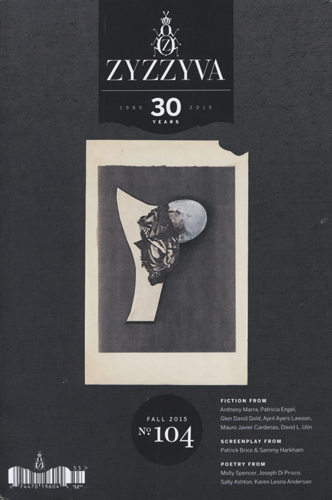ZYZZYVA – Fall 2015
ZYZZYVA’s Fall 2015 issue took me a very long time to review. Not because it was long or dense or difficult, but because I did not want to finish reading. Every time I started to write, I, like a vortex, would be sucked back into reading and my critical abilities would evaporate. I would become that teenie-bopper hiding under the sheets with a flashlight late into the early morning savoring each page, each character, each line. ZYZZYVA’s Fall 2015 issue took me a very long time to review. Not because it was long or dense or difficult, but because I did not want to finish reading. Every time I started to write, I, like a vortex, would be sucked back into reading and my critical abilities would evaporate. I would become that teenie-bopper hiding under the sheets with a flashlight late into the early morning savoring each page, each character, each line.
ZYZZYVA is a thirty-year-old, San Francisco based journal, named after the weevil, which is the tiniest member of the beetle family, or perhaps, also the last word in most dictionaries. They have a solid online presence and tight community links. The print copy is a pleasure to hold, classically designed with the reader in mind. This journal is not for upstart scribblers. It is refined and intelligent, and the contributors are talented. Heck, these were the first state-side publishers of Haruki Murakami, only 91 issues ago.
Editor Laura Cogan has complied a fantastic line-up consisting of eight short stories, eleven poems, a nonfiction piece, a script and the multi-layered visual art of Jay DeFeo, who was a San Francisco based beat artist famous for her one-ton representation of a rose. The choice to include an understated twenty-page film script, “Hang Loose” by Patrick Brice and Sammy Harkham, was risky and rare. The desultory story of an aging surf bum returning to his parent’s house in suburban California, provided a welcomed juxtaposition to the prose and verse, reminding the reader that screenplays can be literature, and that some stories, especially a surfing suburban Californian story, are visual and suit celluloid better.
This issue includes one prose poem, “Finding Time II” by Sally Ashton, both experimental and polished. “Soon, blisters on my feet. The walkway answered every step, the joggers, the students, lovers, the tourists with map and book saying which way now? Crying what more must I see?” This final line expressed how I felt while reading the fiction selections.
Anthony Marra’s “The Last Words of Benito Picone” weaves a series of gems into a compelling narrative about a man obsessed with last words, who ends up dying on Pier 39 watching the sea lions while another utters his final words. The themes of friendship, legacy, and urban loneliness fill the story, which is peppered with fantastic moments that feel ironic, but hyper-realistic:
“Were you watching me sleep? he asked.
“The TV’s broken,” she said. She introduced herself as Marie.
Patricia Engel, who seems to be published everywhere this year, has a sweet but heart-jarring story about a young boy, “Ramiro,” trying to navigate a Colombian slum while both gang and church attempt to enlist. Engel breaks stereotypes while drawing us into a desperate, foreign world with the tight first-person prose of her female narrator.
In “Vulnerability,” April Ayers Lawson describes the journey of a painter, who has come to New York to sell or work or start an affair with her agent or a fellow-painter, whom she befriended on Facebook. The narrative goes deep into an artist’s psyche, swirling with ideas of attraction, and the knowledge that each daily decision could possibly change our lives forever: “I have only known a couple of men like that since. Men whose powers of observation and inner tension suffuse the air; who make me feel as if my presence is as much a problem as my potential absence.” Lawson writes powerful sentences, the kind that make readers underline and remember.
Whether publishing poetry or prose, scripts or photographs, ZYZZYVA has secured a top place in the echelons of contemporary literature journals, and I imagine they will stay there. The editors should be applauded for this intelligent and entertaining issue.
[www.zyzzyva.org]





